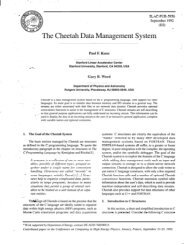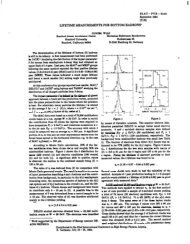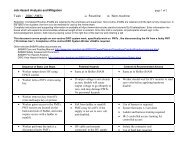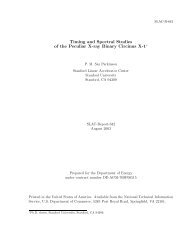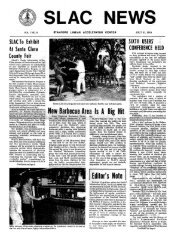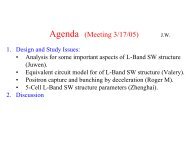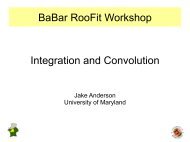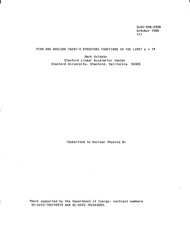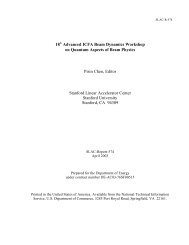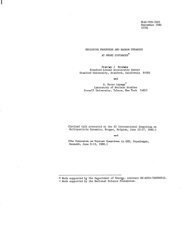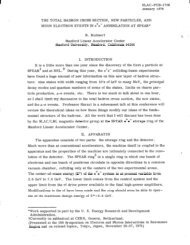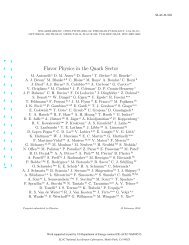The Use and Calibration of the Kern ME5000 Mekometer - SLAC ...
The Use and Calibration of the Kern ME5000 Mekometer - SLAC ...
The Use and Calibration of the Kern ME5000 Mekometer - SLAC ...
Create successful ePaper yourself
Turn your PDF publications into a flip-book with our unique Google optimized e-Paper software.
.<br />
Variance Component Analysis<br />
Here od represents <strong>the</strong> variance <strong>of</strong> <strong>the</strong> distance d, q <strong>the</strong> constant, <strong>and</strong> 0, <strong>the</strong> distance-<br />
dependent term <strong>of</strong> <strong>the</strong> equation. Equations 2-3 <strong>and</strong> 2-4 can not be directly compared: 2-3<br />
is an empirical function while 2-4 is derived through error propagation. <strong>The</strong> exponent H<br />
reflects <strong>the</strong> distance dependency <strong>of</strong> <strong>the</strong> variances. A positive exponent indicates that <strong>the</strong><br />
variance <strong>of</strong> <strong>the</strong> measured distances increases with increasing distance. A negative<br />
exponent indicates that <strong>the</strong> variance <strong>of</strong> <strong>the</strong> measured distances decreases with increasing<br />
distance. It is usually sufficient to limit <strong>the</strong> choice <strong>of</strong> <strong>the</strong> exponent to <strong>the</strong> values +l.O, -1.0,<br />
+0.5, or -0.5.<br />
Normally <strong>the</strong> variance - covariance matrix y is assumed to be known with <strong>the</strong><br />
exception <strong>of</strong> <strong>the</strong> variance o, which is estimated through <strong>the</strong> least squares process.<br />
D(r) =dV (2-5)<br />
In <strong>the</strong> case that variance components are to be estimated <strong>the</strong> stochastic model has to<br />
be exp<strong>and</strong>ed. Suppose <strong>the</strong> vector <strong>of</strong> residuals is composed <strong>of</strong> a linear combination <strong>of</strong> <strong>the</strong><br />
two independent but not directly obtainable residual vectors rl <strong>and</strong> rz, with rI representing<br />
<strong>the</strong> constant <strong>and</strong> r2 <strong>the</strong> distance proportional parts. <strong>The</strong>n <strong>the</strong> associated variance -<br />
covariance matrices can be described as follows:<br />
D(n) = 0: a:<br />
1 0 0 . . .<br />
0 1 0 . . .<br />
0 0 1 . . . Db-2) = d 2 cd<br />
. . . . . . . . . . . . I<br />
2H<br />
dlz 0 0 . . .<br />
0 d;nf 0 . . .<br />
0 0 dtiH . . .<br />
. . . . . . . . . . . .<br />
where or <strong>and</strong> oz represent <strong>the</strong> unknown variance components to be estimated <strong>and</strong> a, <strong>and</strong><br />
a, <strong>the</strong>ir approximate values. <strong>The</strong> values describing <strong>the</strong> accuracy <strong>of</strong> <strong>the</strong> instrument which<br />
are usually supplied by <strong>the</strong> manufacturer can be used as approximate values (see for<br />
example equation 2-3a). <strong>The</strong> total variance - covariance D is a linear combination <strong>of</strong> both<br />
parts <strong>and</strong> is calculated as follows:<br />
G-6)<br />
D =& +o:v, P-7)<br />
where & is <strong>the</strong> product <strong>of</strong> CX~~ <strong>and</strong> <strong>the</strong> associated matrix <strong>and</strong> ok are <strong>the</strong> variance<br />
components for k = 1,2.<br />
Using <strong>the</strong> method <strong>of</strong> least squares adjustment with additional constraints one can<br />
calculate <strong>the</strong> unknowns <strong>and</strong> <strong>the</strong>ir associated statistical values as follows [5]:<br />
2 = (ATD-lA)-lATD+f<br />
-_- --- (2-W<br />
42



